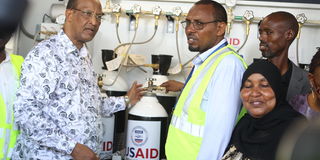Garissa Referral hospital’s oxygen plant to save lives, money

Garissa Governor Nathif Jama (left) at the newly launched oxygen plant at the county referral hospital on May 22, 2023.
At the Garissa County Teaching and Referral Hospital newborn unit, mothers sit beside their babies’ cots as others cradle the infants for kangaroo care.
In a separate room, Halima Mohamed cuddles her son who was born preterm and has been dependent on oxygen for survival. When she fell pregnant, she knew she would name the child Hudheifa, Arabic for “companion of Prophet”. A mother of 11, her dreams were almost dashed when she went into labour at 32 weeks. Her baby’s lungs were not developed enough to breathe.
For two weeks now, Hudheifa has been caring for her baby alongside other mothers, waiting for the day she will finally take him home. According to Abdirahman Adan, the clinician in the newborn unit at the referral hospital, babies like Hudheifa need extra help to breathe.
“The steady flow of air with oxygen coming in through the tubes from the machines keeps enough pressure in the lungs to prevent the air sacs from collapsing after each breath, and the baby learns to breathe on their own,” the clinician said.
Abdirahman said he sees babies like Hudheifa all the time, in desperate need of oxygen born in the hospital or referred from as far as Somalia. In 2022 alone, 1,098 preterm babies were admitted to the hospital’s neonatal intensive care unit (Nicu), with different medical challenges. At any given time, the facility has at least 17 babies, in a ward with a maximum capacity for 20.
The county has been buying oxygen to help such infants from as far as Nairobi. Now, with the installation of an oxygen-generating plant at the referral hospital, the babies have a better chance at life.
The plant, which was launched by Governor Nathif Aden, will see the county save the Sh600,000 it spends monthly on procuring oxygen.
The 283-litres per minute plant is worth approximately Sh26.8 million. It can fill 10 oxygen cylinders in 24 hours.
Speaking during the launch, Mr Aden said counties need support to strengthen health systems in the North Eastern Region.
“We hire more health workers, build hospitals but we need support to equip them to a state that can serve the community,” said Mr Nathif.
Health executive Ahmednadhir Omar said that the county spent at least Sh245,000 per month to purchase oxygen, excluding transport costs, to administer to patients at the referral hospital alone.
“Garissa Level Five Hospital has a catchment area of four million people and attends to patients referred from 126 health facilities in the county and the neighbouring Tana River, Kitui, Isiolo and Wajir counties. The hospital also receives patients from Somalia,” said Mr Omar.
“The PSA oxygen generating plant is the most affordable means to deliver the oxygen as compared to storing the oxygen in cylinders that need refilling, which is 10 times more expensive,” he added.
Ms Rosemary Njogu, the Senior Programme Lead for the RISE project being run by Jhpiego, stated that besides the availability of oxygen, healthcare workers also need to have skills to save lives.
“We trained various health workers to use and track the oxygen, medical engineers on how to operate the plant, rational use of oxygen and cylinder handling. They then trained their colleagues in other healthcare facilities and exchanged information about the patients they are seeing through a WhatsApp group,” said Ms Njogu.
According to the World Health Organization (WHO), “prematurity is the leading cause of death in children under the age of five years”. The organisation defines preterm births as those born alive before 37 weeks. Those born at less than 28 weeks are considered extremely preterm.
WHO indicates that preterm birth occurs for a variety of reasons, with most happening spontaneously. Some are due to infections or other pregnancy complications that require early induction of labour or caesarean birth. Other causes include multiple pregnancies, chronic conditions such as diabetes and high blood pressure as well as genetic influence.





